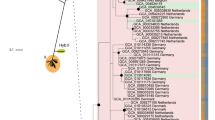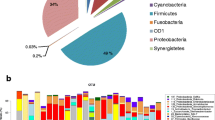Abstract
The purpose of this study was to use microbiological culture and bacterial 16S rRNA gene sequencing methods to detect transcriptionally active bacteria present on the surface of failed prosthetic hip joints removed during revision arthroplasty. Five failed prosthetic hip joints were sonicated to dislodge adherent bacteria and subjected to microbiological culture. Bacterial RNA was extracted from each sonicate, cDNA prepared by reverse transcription and the 16S rRNA gene amplified using universal primers. Polymerase chain reaction (PCR) products were cloned, assigned to distinct groups by restriction fragment length polymorphism (RFLP) analysis and one representative clone from each group was sequenced. Bacteria were identified by comparison of the obtained 16S rRNA gene sequences with those deposited in public access sequence databases. All five specimens were positive for the presence of bacteria by both culture and PCR. Culture methods identified species from eight genera. Molecular detection of transcriptionally active bacteria identified a wider range of species. A total of 42 phylotypes were identified, of which Lysobacter gummosus was the most abundant (31.6%). Thirty-four clones (14.5%) represented uncultivable phylotypes. No potentially novel species were identified. It is concluded that a diverse range of transcriptionally active bacterial species are present within biofilms on the surface of failed prosthetic hip joints.
Similar content being viewed by others
References
Patel R, Osmon DR, Hanssen AD (2005) The diagnosis of prosthetic joint infection: current techniques and emerging technologies. Clin Orthop Relat Res 437:55–58
Toms AD, Davidson D, Masri BA, Duncan CP (2006) The management of peri-prosthetic infection in total joint arthroplasty. J Bone Joint Surg Br 88:149–155
NHS Direct Health Encyclopaedia. Hip replacement. Available online at: http://www.nhsdirect.nhs.uk/articles/article.aspx?articleId=522
Lentino JR (2003) Prosthetic joint infections: bane of orthopedists, challenge for infectious disease specialists. Clin Infect Dis 36:1157–1161
Lachiewicz PF, Rogers GD, Thomason HC (1996) Aspiration of the hip joint before revision total hip arthroplasty. Clinical and laboratory factors influencing attainment of a positive culture. J Bone Joint Surg Am 78:749–754
Thomas JG, Ramage G, Lopez-Ribot JL (2004) Biofilms and implant infections. In: Ghannoum M, O’Toole G (eds) Microbial biofilms. American Society of Microbiology Press, Washington, pp 269–293
Atkins BL, Athanasou N, Deeks JJ, Crook DWM, Simpson H, Peto TEA, McLardy-Smith P, Berendt AR (1998) Prospective evaluation of criteria for microbiological diagnosis of prosthetic-joint infection at revision arthroplasty. The OSIRIS Collaborative Study Group. J Clin Microbiol 36:2932–2939
Tunney MM, Patrick S, Gorman SP, Nixon JR, Anderson N, Davis RI, Hanna D, Ramage G (1998) Improved detection of infection in hip replacements. A currently underestimated problem. J Bone Joint Surg Br 80:568–572
Dempsey KE, Riggio MP, Lennon A, Hannah VE, Ramage G, Allan D, Bagg J (2007) Identification of bacteria on the surface of clinically infected and non-infected prosthetic hip joints removed during revision arthroplasties by 16S rRNA gene sequencing and by microbiological culture. Arthritis Res Ther 9:R46
Trampuz A, Piper KE, Jacobson MJ, Hanssen AD, Unni KK, Osmon DR, Mandrekar JN, Cockerill FR, Steckelberg JM, Greenleaf JF, Patel R (2007) Sonication of removed hip and knee prostheses for diagnosis of infection. N Engl J Med 357:654–663
Clarke MT, Roberts CP, Lee PTH, Gray J, Keene GS, Rushton N (2004) Polymerase chain reaction can detect bacterial DNA in aseptically loose total hip arthroplasties. Clin Orthop Relat Res 427:132–137
Tunney MM, Patrick S, Curran MD, Ramage G, Hanna D, Nixon JR, Gorman SP, Davis RI, Anderson N (1999) Detection of prosthetic hip infection at revision arthroplasty by immunofluorescence microscopy and PCR amplification of the bacterial 16S rRNA gene. J Clin Microbiol 37:3281–3290
Mariani BD, Tuan RS (1998) Advances in the diagnosis of infection in prosthetic joint implants. Mol Med Today 4:207–213
Levine MJ, Mariani BA, Tuan RS, Booth RE Jr (1995) Molecular genetic diagnosis of infected total joint arthroplasty. J Arthroplasty 10:93–94
Cox CJ, Kempsell KE, Hill Gaston JS (2003) Investigation of infectious agents associated with arthritis by reverse transcription PCR of bacterial rRNA. Arthritis Res Ther 5:R1–R8
Kempsell KE, Cox CJ, Hurle M, Wong A, Wilkie S, Zanders ED, Hill Gaston JS, Crowe JS (2000) Reverse transcriptase-PCR analysis of bacterial rRNA for detection and characterization of bacterial species in arthritis synovial tissue. Infect Immun 68:6012–6026
Lane DJ (1991) 16S/23S rRNA sequencing. In: Stackebrandt E, Goodfellow M (eds) Nucleic acid techniques in bacterial systematics. John Wiley and Sons, New York, pp 115–175
Riggio MP, Lennon A, Wray D (2000) Detection of Helicobacter pylori DNA in recurrent aphthous stomatitis tissue by PCR. J Oral Pathol Med 29:507–513
Altschul SF, Madden TL, Schäffer AA, Zhang J, Zhang Z, Miller W, Lipman DJ (1997) Gapped BLAST and PSI-BLAST: a new generation of protein database search programs. Nucleic Acids Res 25:3389–3402
Shimizu A, Akiyama M, Ishijima Y, Hama K, Kunimaru T, Naganuma T (2006) Molecular characterization of microbial communities in fault-bordered aquifers in the Miocene formation of northernmost Japan. Geobiol 4:203–213
Bartzokas CA, Johnson R, Jane M, Martin MV, Pearce PK, Saw Y (1994) Relation between mouth and haematogenous infection in total joint replacements. Br Med J 309:506–508
Stoll T, Stucki G, Brühlmann P, Vogt M, Gschwend N, Michel BA (1996) Infection of a total knee joint prosthesis by Peptostreptococcus micros and Propionibacterium acnes in an elderly RA patient: implant salvage with longterm antibiotics and needle aspiration/irrigation. Clin Rheumatol 15:399–402
Waldman BJ, Mont MA, Hungerford DS (1997) Total knee arthroplasty infections associated with dental procedures. Clin Orthop Relat Res 343:164–172
LaPorte DM, Waldman BJ, Mont MA, Hungerford DS (1999) Infections associated with dental procedures in total hip arthroplasty. J Bone Joint Surg Br 81:56–59
Tronstad L, Sunde PT (2003) The evolving new understanding of endodontic infections. Endod Top 6:57–77
Lockhart PB, Loven B, Brennan MT, Fox PC (2007) The evidence base for the efficacy of antibiotic prophylaxis in dental practice. J Am Dent Assoc 138:458–474
Fenollar F, Roux V, Stein A, Drancourt M, Raoult D (2006) Analysis of 525 samples to determine the usefulness of PCR amplification and sequencing of the 16S rRNA gene for diagnosis of bone and joint infections. J Clin Microbiol 44:1018–1028
Zimmerli W, Trampuz A, Ochsner PE (2004) Prosthetic-joint infections. N Engl J Med 351:1645–1654
Panousis K, Grigoris P, Butcher I, Rana B, Reilly JH, Hamblen DL (2005) Poor predictive value of broad-range PCR for the detection of arthroplasty infection in 92 cases. Acta Orthop 76:341–346
An SY, Asahara M, Goto K, Kasai H, Yokota A (2007) Virgibacillus halophilus sp. nov., spore-forming bacteria isolated from soil in Japan. Int J Syst Evol Microbiol 57:1607–1611
Graur D, Pupko T (2001) The Permian bacterium that isn’t. Mol Biol Evol 18:1143–1146
D’Amico M, Mangano S, Spinelli M, Sala E, Vigano EF, Grilli R, Fraticelli M, Grillo C, Limido A (2005) Epidemic of infections caused by ‘aquatic’ bacteria in patients undergoing hemodialysis via central venous catheters. G Ital Nefrol 22:508–513
Chi C-Y, Fung C-P, Wong W-W, Liu C-Y (2004) Brevundimonas bacteremia: two case reports and literature review. Scand J Infect Dis 36:59–61
Sofer Y, Zmira S, Amir J (2007) Brevundimonas vesicularis septic arthritis in an immunocompetent child. Eur J Pediatr 166:77–78
Marques da Silva R, Caugant DA, Eribe ERK, Aas JA, Lingaas PS, Geiran O, Tronstad L, Olsen I (2006) Bacterial diversity in aortic aneurysms determined by 16S ribosomal RNA gene analysis. J Vasc Surg 44:1055–1060
Paster BJ, Falkler WA Jr, Enwonwu CO, Idigbe EO, Savage KO, Levanos VA, Tamer MA, Ericson RL, Lau CN, Dewhirst FE (2002) Prevalent bacterial species and novel phylotypes in advanced noma lesions. J Clin Microbiol 40:2187–2191
Wildeboer-Veloo ACM, Harmsen HJM, Welling GW, Degener JE (2007) Development of 16S rRNA-based probes for the identification of Gram-positive anaerobic cocci isolated from human clinical specimens. Clin Microbiol Infect 13:985–992
Song Y, Liu C, Finegold SM (2007) Peptoniphilus gorbachii sp. nov., Peptoniphilus olsenii sp. nov., and Anaerococcus murdochii sp. nov. isolated from clinical specimens of human origin. J Clin Microbiol 45:1746–1752
Looney WJ (2005) Role of Stenotrophomonas maltophilia in hospital-acquired infection. Br J Biomed Sci 62:145–154
Guilhabert MR, Kirkpatrick BC (2005) Identification of Xylella fastidiosa antivirulence genes: hemagglutinin adhesins contribute to X. fastidiosa biofilm maturation and colonization and attenuate virulence. Mol Plant Microbe Interact 18:856–868
Jacques M-A, Josi K, Darrasse A, Samson R (2005) Xanthomonas axonopodis pv. phaseoli var. fuscans is aggregated in stable biofilm population sizes in the phyllosphere of field-grown beans. Appl Environ Microbiol 71:2008–2015
Huang T-P, Somers EB, Wong ACL (2006) Differential biofilm formation and motility associated with lipopolysaccharide/exopolysaccharide-coupled biosynthetic genes in Stenotrophomonas maltophilia. J Bacteriol 188:3116–3120
Kämpfer P, Rosselló-Mora R, Hermansson M, Persson F, Huber B, Falsen E, Busse HJ (2007) Undibacterium pigrum gen. nov., sp. nov., isolated from drinking water. Int J Syst Evol Microbiol 57:1510–1515
Simões LC, Simões M, Vieira MJ (2007) Biofilm interactions between distinct bacterial genera isolated from drinking water. Appl Environ Microbiol 73:6192–6200
Saxena N, Misra R, Aggarwal A (2006) Is the enthesitis-related arthritis subtype of juvenile idiopathic arthritis a form of chronic reactive arthritis? Rheumatology 45:1129–1132
Abraham WR, Strömpl C, Meyer H, Lindholst S, Moore ER, Christ R, Vancanneyt M, Tindall BJ, Bennasar A, Smit J, Tesar M (1999) Phylogeny and polyphasic taxonomy of Caulobacter species. Proposal of Maricaulis gen. nov. with Maricaulis maris (Poindexter) comb. nov. as the type species, and emended description of the genera Brevundimonas and Caulobacter. Int J Syst Bacteriol 49:1053–1073
Smith JL, Fratamico PM, Gunther NW (2007) Extraintestinal pathogenic Escherichia coli. Foodborne Pathog Dis 4:134–163
Falagas ME, Karveli EA, Kelesidis I, Kelesidis T (2007) Community-acquired Acinetobacter infections. Eur J Microbiol Infect Dis 26:857–868
Davies JC, Rubin BK (2007) Emerging and unusual gram-negative infections in cystic fibrosis. Semin Respir Crit Car Med 28:312–321
Torres-Tortosa M, Arrizabalaga J, Villanueva JL, Gálvez J, Leyes M, Valencia ME, Flores J, Peña JM, Pérez-Cecilia E, Quereda C (2003) Prognosis and clinical evaluation of infection caused by Rhodococcus equi in HIV-infected patients: a multicenter study of 67 cases. Chest 123:1970–1976
Rozsypal H, Aster V, Stahiková M, Horová B (2007) Rhodococcus equi infection in subjects infected with human immunodeficiency virus (HIV). Cas Lek Cesk 146:163–167
North NN, Dollhopf SL, Petrie L, Istok JD, Balkwill DL, Kostka JE (2004) Change in bacterial community structure during in situ biostimulation of subsurface sediment cocontaminated with uranium and nitrate. Appl Environ Microbiol 70:4911–4920
Huber JA, Johnson HP, Butterfield DA, Baross JA (2006) Microbial life in ridge flank crustal fluids. Environ Microbiol 8:88–99
Kaiser O, Pühler A, Selbitschka W (2001) Phylogenetic analysis of microbial diversity in the rhizoplane of oilseed rape (Brassica napus cv. Westar) employing cultivation-dependent and cultivation-independent approaches. Microb Ecol 42:136–149
Rawls JF, Mahowald MA, Ley RE, Gordon JI (2006) Reciprocal gut microbiota transplants from zebrafish and mice to germ-free recipients reveal host habitat selection. Cell 127:423–433
Williams MM, Domingo JWS, Meckes MC, Kelty CA, Rochon HS (2004) Phylogenetic diversity of drinking water bacteria in a distribution system simulator. J Appl Microbiol 96:954–964
Flanagan JL, Brodie EL, Weng L, Lynch SV, Garcia O, Brown R, Hugenholtz P, DeSantis TZ, Andersen GL, Wiener-Kronish JP, Bristow J (2007) Loss of bacterial diversity during antibiotic treatment of intubated patients colonized with Pseudomonas aeruginosa. J Clin Microbiol 45:1954–1962
Oliver JD (2005) The viable but nonculturable state in bacteria. J Microbiol 43 Spec No:93–100
Giesler LJ, Yuen GY (1998) Evaluation of Stenotrophomonas maltophilia strain C3 for biocontrol of brown patch disease. Crop Prot 17:509–513
Senol E (2004) Stenotrophomonas maltophilia: the significance and role as a nosocomial pathogen. J Hosp Infect 57:1–7
Denton M, Kerr KG (1998) Microbiological and clinical aspects of infection associated with Stenotrophomonas maltophilia. Clin Microbiol Rev 11:57–80
Acknowledgements
We thank Dr. Dominic Meek for the provision of the prosthetic hip joint samples and Dr. Grace Sweeney for conducting bacteriology on the pre-operative and peri-operative samples. This research was funded by the Arthritis Research Campaign (grant number 16418).
Author information
Authors and Affiliations
Corresponding author
Rights and permissions
About this article
Cite this article
Riggio, M.P., Dempsey, K.E., Lennon, A. et al. Molecular detection of transcriptionally active bacteria from failed prosthetic hip joints removed during revision arthroplasty. Eur J Clin Microbiol Infect Dis 29, 823–834 (2010). https://doi.org/10.1007/s10096-010-0934-y
Received:
Accepted:
Published:
Issue Date:
DOI: https://doi.org/10.1007/s10096-010-0934-y




